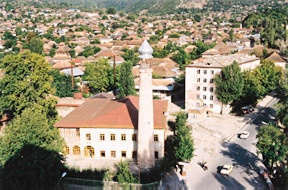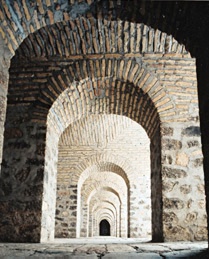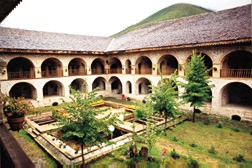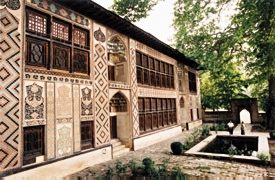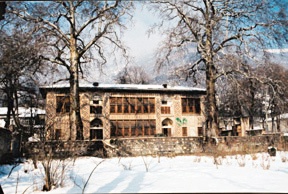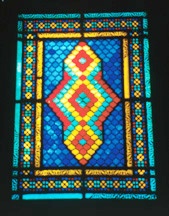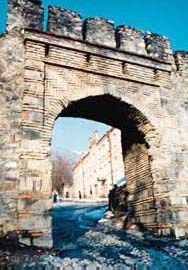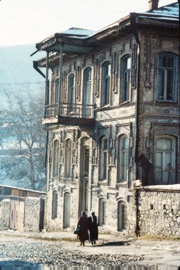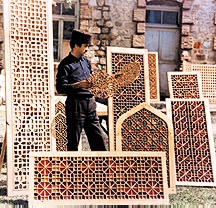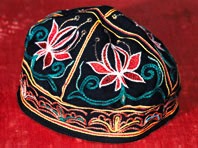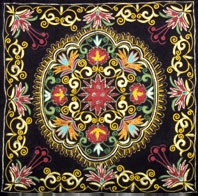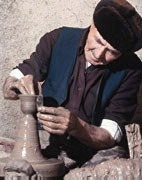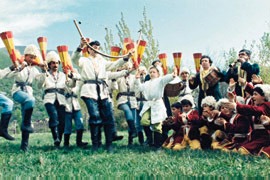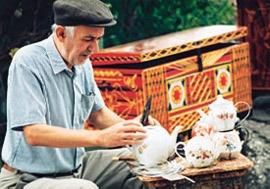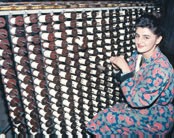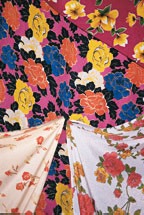|
Summer 1998 (6.2) Shaki
Shaki is one of the most ancient towns in the Caucasus. It dates back to the Late Bronze Age and played a vital role in the development of Azerbaijani culture throughout the ages. The designation of a "Silk Road" connecting the West to the East directly applies to Shaki, for it was once a great silk center. Merchants passing through the town stayed at one of its five "caravanserais." In these two-storied "hotels for camel caravans," the goods, horses and camels were kept downstairs, while the merchants stayed in rooms upstairs. Many travelers used to stay there since Shaki was a transit town between east and west as well as between north and south.
Shaki grew to become one of the largest towns in Azerbaijan. Today, it has a population of approximately 90,000. Shaki "Must-Sees" The five-hour trip from Baku to Shaki is well worth the effort. There are many places to see. The ideal time to visit is during any season except for winter. Situated like an amphitheater surrounded by mountains and forests of oak trees, Shaki rises above fertile yaylags (pastures) and fields. In town, you'll see brick houses, weeping willow trees and canals carrying spring water. The Palace of the Khans is an absolute must-see for any visitor. Tour guides will gladly show you around, although they may not know English.
One of the most striking architectural features of the residence is its wooden framed stained glass windows known as "shabaka." Shabaka is a combination of hundreds of hand-crafted pieces of wood (platino and poplar trees) so carefully crafted that they fit together firmly without the use of a single nail. (See our back cover.) For a closer look at how shabaka is made, there is a local workshop adjacent to the palace. The craftsman or one of his apprentices may be there to show you around.
Left: Shaki Palace of the Khans. Photo: Khanlou.
Inside the Palace of the Khans, you'll find murals painted on the walls. Some depict romantic, pastoral scenes of gazelle hunting, as well as pictures based on stories told by the 12th century Middle Eastern poet Nizami. In the wife's quarters, the walls are painted with flowers; in the khan's rooms, depictions of battle cover the walls.
The ground floor rooms were used in the winter for living and were furnished with fireplaces-bukhary. The upper floor is completely ceremonial and corresponds to the ground floor in plan. In 1952, under the supervision of one of the leading architects of the republic, Niyazi Rezayev, the Shaki Khans' Palace was, for the first time, measured and studied. The restoration work was completed in 1967 and the monument was given a second birth. Unfortunately, the palace today is in great need of repair, and some of the murals are in great danger of being lost. Shaki Crafts
The biggest employer in town is the silk factory, where the whole process is carried out, from the cocoon to the weaving and dyeing of material. During the Soviet period, as many as 7,000 employees worked shifts around the clock. It may not be possible to visit the factory as a general tourist, but if you are with some Azerbaijanis, you may be able to get in. Silk making is extremely labor-intensive. The work conditions are extremely difficult. For example, the noise of the looms is unbelievably deafening and workers are extremely low-paid (less than $10 per month).
As you walk down the shaded streets of Shaki, you are likely to hear the tap-tap-tap of hammers. That's the sound of tin being worked into the shape of water containers, trays and lamps. "Misgars," or coppersmiths, have passed down their trade from generation to generation for several centuries. Their skills have been in great demand by both the townspeople and outlying cattle-breeding households, who need tin products for everyday use. Photo: Pottery Maker in Shaki. Photo: Litvin
Above Left: Novruz celebration in Shaki. Right: Attaching lids to teapots. Chest in background is typical of Shaki handcraft. Photos: Litvin. A window shopper in late 19th century Paris or St. Petersburg would have been likely to see Shaki jewelry, such as earrings, bracelets, and broaches, on display. At the time, at least 30 Shaki workshops were producing women's jewelry as well as silver belt buckles, pendants, tableware and decorations for daggers and sabers. Chromium-plated silver items, such as women's belts and bracelets, were especially popular. The use of enamel made these items more durable.
Photos: Left: silk mill looms. Right: Preparing
the spools for the silk looms. Photos: Blair Don't forget to visit the bazaar, especially on weekends. The bazaar in Shaki is one of the largest in the countryside. Besides the usual fruits, vegetables, meat and cheese, you'll find locally made pottery, hand-knitted stockings for children and hand woven carpets. Tips For Your Stay While you're there, treat yourself
to some steaming hot "piti." Piti is a stew made with
lamb, which simmers over low heat in little clay pots, separately
for each person. People living in Shaki are particularly fond
of this Middle Eastern dish. Shishlik, lamb kabobs, are also
a favorite. For dessert, try some sweet halva with some hot tea.
Local honey, served with freshly baked bread in the morning for
breakfast, is extraordinarily delicious as well. |

